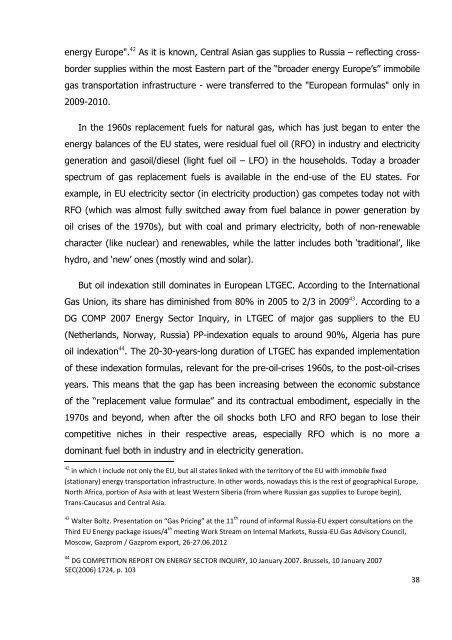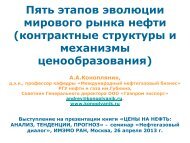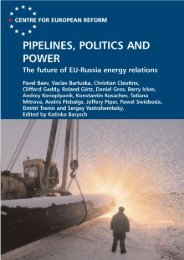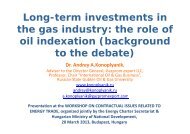Oil, Gas & Energy Law Intelligence
Oil, Gas & Energy Law Intelligence
Oil, Gas & Energy Law Intelligence
You also want an ePaper? Increase the reach of your titles
YUMPU automatically turns print PDFs into web optimized ePapers that Google loves.
energy Europe". 42 As it is known, Central Asian gas supplies to Russia – reflecting crossbordersupplies within the most Eastern part of the “broader energy Europe’s” immobilegas transportation infrastructure - were transferred to the "European formulas" only in2009-2010.In the 1960s replacement fuels for natural gas, which has just began to enter theenergy balances of the EU states, were residual fuel oil (RFO) in industry and electricitygeneration and gasoil/diesel (light fuel oil – LFO) in the households. Today a broaderspectrum of gas replacement fuels is available in the end-use of the EU states. Forexample, in EU electricity sector (in electricity production) gas competes today not withRFO (which was almost fully switched away from fuel balance in power generation byoil crises of the 1970s), but with coal and primary electricity, both of non-renewablecharacter (like nuclear) and renewables, while the latter includes both ‘traditional’, likehydro, and ‘new’ ones (mostly wind and solar).But oil indexation still dominates in European LTGEC. According to the International<strong>Gas</strong> Union, its share has diminished from 80% in 2005 to 2/3 in 2009 43 . According to aDG COMP 2007 <strong>Energy</strong> Sector Inquiry, in LTGEC of major gas suppliers to the EU(Netherlands, Norway, Russia) PP-indexation equals to around 90%, Algeria has pureoil indexation 44 . The 20-30-years-long duration of LTGEC has expanded implementationof these indexation formulas, relevant for the pre-oil-crises 1960s, to the post-oil-crisesyears. This means that the gap has been increasing between the economic substanceof the “replacement value formulae” and its contractual embodiment, especially in the1970s and beyond, when after the oil shocks both LFO and RFO began to lose theircompetitive niches in their respective areas, especially RFO which is no more adominant fuel both in industry and in electricity generation.42 in which I include not only the EU, but all states linked with the territory of the EU with immobile fixed(stationary) energy transportation infrastructure. In other words, nowadays this is the rest of geographical Europe,North Africa, portion of Asia with at least Western Siberia (from where Russian gas supplies to Europe begin),Trans‐Caucasus and Central Asia.43 Walter Boltz. Presentation on “<strong>Gas</strong> Pricing” at the 11 th round of informal Russia‐EU expert consultations on theThird EU <strong>Energy</strong> package issues/4 th meeting Work Stream on Internal Markets, Russia‐EU <strong>Gas</strong> Advisory Council,Moscow, Gazprom / Gazprom export, 26‐27.06.201244 DG COMPETITION REPORT ON ENERGY SECTOR INQUIRY, 10 January 2007. Brussels, 10 January 2007SEC(2006) 1724, p. 10338












